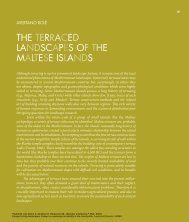high nature value farmland and traditional agricultural landscapes
high nature value farmland and traditional agricultural landscapes
high nature value farmland and traditional agricultural landscapes
You also want an ePaper? Increase the reach of your titles
YUMPU automatically turns print PDFs into web optimized ePapers that Google loves.
Figure 4a. Trends in <strong>farml<strong>and</strong></strong> birds – (http://www.ebcc.info/pecbm.html) Figure 4b. N-fertiliser input (Source: EEA)<br />
categorised into livestock systems, arable <strong>and</strong> permanent crop systems, <strong>and</strong> mixed systems. Typical examples<br />
include semi-natural grassl<strong>and</strong>s, olive trees <strong>and</strong> vines under <strong>traditional</strong> management, <strong>traditional</strong> orchards,<br />
fallow l<strong>and</strong>, wood pastures, <strong>and</strong> bocage. Management practices also share some common characteristics: the<br />
use of terraces (typical of the Mediterranean area) <strong>and</strong> hedgerows, minimal tillage, mulching, small field sizes<br />
<strong>and</strong> long fallow cycles (Altieri 1990).<br />
TradITIonal l<strong>and</strong>scapes, hIGh naTUre<br />
ValUe farMl<strong>and</strong> <strong>and</strong> bIodIVersITy<br />
It is only in recent decades that the link between <strong>traditional</strong> European <strong>agricultural</strong> l<strong>and</strong>scapes <strong>and</strong> biodiversity<br />
has been investigated <strong>and</strong> the importance of European agri-biodiversity recognised. The term “High Nature<br />
Value <strong>farml<strong>and</strong></strong>” was introduced at the beginning of the 1990s (Baldock et al. 1993, Beaufoy et al. 1994) referring<br />
to the low input farming systems associated with <strong>high</strong> biodiversity. The concept was further developed<br />
by Andersen et al. (2003), who coined the definition “areas in Europe where agriculture is a major (usually the<br />
dominant) l<strong>and</strong> use <strong>and</strong> where that agriculture supports, or is associated with, either a <strong>high</strong> species <strong>and</strong> habitat<br />
diversity or the presence of species of European conservation concern, or both”.<br />
Areas of High Nature Value <strong>farml<strong>and</strong></strong> largely overlap with <strong>traditional</strong> <strong>agricultural</strong> l<strong>and</strong>scapes, having<br />
as common denominator low input farming systems. A more detailed quantification (in spatial <strong>and</strong> typological<br />
terms) of such overlap is hardly feasible, since no comprehensive guide exists of European <strong>traditional</strong><br />
l<strong>and</strong>scapes (Zimmermann 2006), <strong>and</strong> currently available descriptions of farming systems maintaining HNV<br />
<strong>farml<strong>and</strong></strong> (EEA 2004) are still too crude for this purpose, or only locally available (Paracchini et al. 2007).<br />
Furthermore, the link with the cultural elements or traditions that have generated such systems is often only<br />
known locally.<br />
The <strong>high</strong> degree of biodiversity that characterises HNV <strong>farml<strong>and</strong></strong> areas was built up over millennia of<br />
anthropic l<strong>and</strong> management, during which agri-ecosystems developed in conjunction with human culture.<br />
The European Community Action Plan for Biodiversity in Agriculture (2001) identifies three dimensions<br />
of <strong>agricultural</strong> biodiversity: the genetic variety of domesticated plants <strong>and</strong> animals, wild biodiversity<br />
(wild flora <strong>and</strong> fauna related to <strong>farml<strong>and</strong></strong>) <strong>and</strong> life support systems (soil organisms, pollinators, predators). The<br />
present chapter deals with the second category: wild flora <strong>and</strong> fauna or wildlife <strong>and</strong> habitats in the terminology<br />
adopted by the Convention on Biological Diversity. Furthermore, a distinction is made between species<br />
diversity within the <strong>agricultural</strong> system <strong>and</strong> the contribution to overall species diversity at a <strong>high</strong>er spatial<br />
scale, including the effects of agriculture on surrounding natural systems (Hoogeveen 2002).<br />
The maintenance of <strong>agricultural</strong> habitats with <strong>high</strong> natural <strong>value</strong> is restricted to a limited range of <strong>agricultural</strong><br />
inputs (Figure 3), which gives HNV systems a <strong>high</strong> degree of instability (Plieninger et al. 2006). The<br />
Pedroli B, Van Doorn A, De Blust G, Paracchini ML, Wascher D & Bunce F (Eds. 2007).<br />
Europe’s living l<strong>and</strong>scapes. Essays on exploring our identity in the countryside. LANDSCAPE EUROPE / KNNV.<br />
| 23




